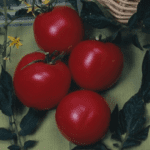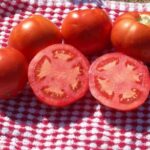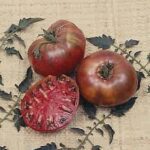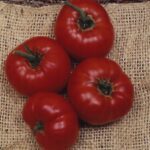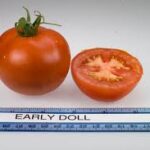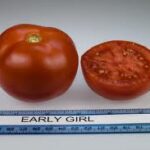HYBRID HOME GARDEN VARIETIES.
Garden varieties are softer then commercial types. If you are growing for a produce auction or
a wholesale account, do not grow these types as they are too soft.
TOMATOES Approximately 10,000 seeds per oz.
A little over 100 years ago tomatoes or Love Apples as they were called then, were grown for ornamental purpose and not for food. They were looked upon with suspicion as the cause of various diseases & were thought to be poisonous. First used as food in Italy, then France and England. Modern types appear to have come on the market in this country during the 19th
century. The 1st record of this fruit quoted on the market was in New Orleans,1812. Seed growers 1st offered tomatoes in 1818
PLANTING: Start seeds indoors, 5-7 weeks before transplanting outdoors. Use Jiffy 7’s or flats with inserts with a good soil substitute, like Berger BM-2. Do not use field or garden soil as it may harbor a disease. Place seeds 1/16″ deep. Cover lightly. Keep moist, not wet. Germinate at 80F until emerge. Do not start tomato seeds in a cold frame if soil temperatures gets below 70°F at anytime after your seed has been sown. After emerge reduce temperatures to 60-65°F until transplanted
outdoors after all danger of frost is past and soil has warmed up. Place plants 18-24″ apart in a row spacing of 4-6′ apart. If plants are planted into plastic mulch, make sure you have water supply source like a drip line under the plastic mulch. Plants can be caged or staked for support. If using the stake method, you can use the weave method. Place a stake in between 2nd or 3rd plant. Now start at the beginning of the row at first stake, tie your string to 1st stake. Take string around the outside of
plants on one side to next stake. Wrap string around stake 2 or 3 times. Now continue down the row with string on the same side of row until you reach the end. Wrap string around last stake 3 or 4 times and now go back up the other side and do the same. When you are done, your tomato plants should have a string on either side of them to give them support. Repeat this process as plant grows. Strings should be 6″ apart. Tomato tying twine is found in the supply section of this catalog. To make stringing easier, do the following: take a 3/4″ PVC pipe about 3′ long. From top down and bottom up, 4″ drill a 1/4″ hole. Run your string in top of pipe and out top hole and into bottom hole out the bottom of pipe. Now you have a handy tool and a time saver. Follow above tying instructions. This tool works as a handle. When you get to a stake, put hand or fingers over string on outside of pipe. This works as a brake to tighten up your string. HARVEST: Pick gently when fruit is fully developed and of a
good color. Use fresh or can for later use.
After each tomato variety, you will find a letter or a row of letters. See below for examples and what they mean.
MOUNTAIN FRESH F1 D VFF
1 2 3
1) F1 Hybrid. Better disease tolerance than open pollinated types. Seeds will not be true if
saved from these fruits.
OP Open pollinated. Also called Heirlooms. Seeds can be saved.
PVP Plant Variety Protected. Do not save seed from this variety to be sold as seed. Any part of plant can be
sold, including fruits or pods except seeds to be planted. It is an open pollinated variety that is protected
by law from seed selling. Not a heirloom plant.
2) D Determinate. Plant habit where vine ceases to grow once it reaches a particular
size. Sets fruits at one time and then tapers off. A good choice for short stakes.
I Indeterminate. Plant continues to grow and has fruit set in all stages, from blossom
to mature. Most varieties are bred for a home garden and have soft fruits.
3) Plants are resistant or can tolerate the following disease:
A = Alternaria F= Fusarium wilt race # 1
L= Septoria leaf spot N= Nematodes
ST= Stemphylium T= Tobacco Mosaic virus
TS= Tomato Spotted Wilt Virus
PKT size: F1 or hybrids, 25 seeds or 1/450 oz Rest about 100 seeds or 1/70 oz.
You will need 12 to 16 plants per 25 foot row or 3,400 to 4,500 plants per acre.





